CNC Machining Laboratory
Purpose of the laboratory
The purpose of machining laboratory is to provide a room for the students’ practices in case of the different subjects. The students perform practical activities in the framework of subjects entitled „Production Engineering I and II” as well as „CNC Basic Knowledge”. The main purpose is to acquire and try the use and programming of the computer-controlled machine tools. The students can acquire wide knowledge in the field of metal cutting.
Competence of the laboratory
- Demonstrating of the real production and the modern CNC technologies
- Performing different research activities (Scientific Students’ Association, Thesis, PhD research work, Habilitation)
- Taking of industrial commissions
- Production of cut parts necessary for making motor vehicles
- Training
Our partners
- WNT Hungary Ltd.
- Enterprise Communications Ltd.
- Seco-Tools Ltd.
- Szimikron Ltd.
Equipment in the laboratory
Equipment suitable for demonstrating the basic machining procedures and machines used in the field of production technology can be found in the CNC machining laboratory. The following machines are available in the laboratory: an OPTI M2 type CNC miller, an OPTI L28 type CNC turning machine, and an OPTI D280x700 type universal centre lathe. In addition, conventional machine tools, a universal centre lathe machine, a universal milling machine, a shaper, a Fellow toothing machine, a framed sawing machine as well as a grinding machine used for sharpening the tools can also be found in the laboratory. Simulation software and the computer background supporting it are available for ten students for practicing and controlling the CNC programming procedure.
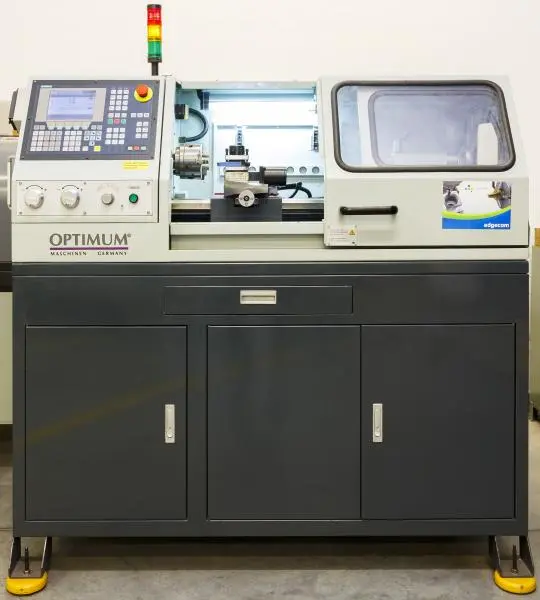

Robert Bosch Automotive Steering Engineering Education and Development Laboratory
Purpose of the laboratory
The Robert Bosch Automotive Steering Engineering Education and Development Laboratory was established by the Robert Bosch Automotive Steering Ltd (formerly ZF Lenksysteme Hungária Ltd) in 2014. The laboratory is suitable for the realization of complex engineering projects. The main purpose of the laboratory is to help students to acquire the ability to cooperative engineering design work. Thanks to its modern education equipment and top-class steering systems, the laboratory ensures the appropriate background for engineering related research.
Competence of the laboratory
The Laboratory is suitable for implementing modern engineering projects. In the laboratory modern education equipment, workstation computers with appropriate software can be found. The laboratory is also equipped with the products of Robert Bosch Automotive Steering Ltd, wall mounted steering system models and steering columns, technical documentation and books about Bosch products. Students have the opportunity to investigate real steering systems in the laboratory, which is also a scientific and technical background for PhD students.
Our partners
Robert Bosch Automotive Steering Ltd
Equipment in the laboratory
- Workstation computers
- Software for mechanical engineering simulation and design (Ansys, Femap, Creo, Solid Edge, SolidWorks),
- Advanced education equipment.
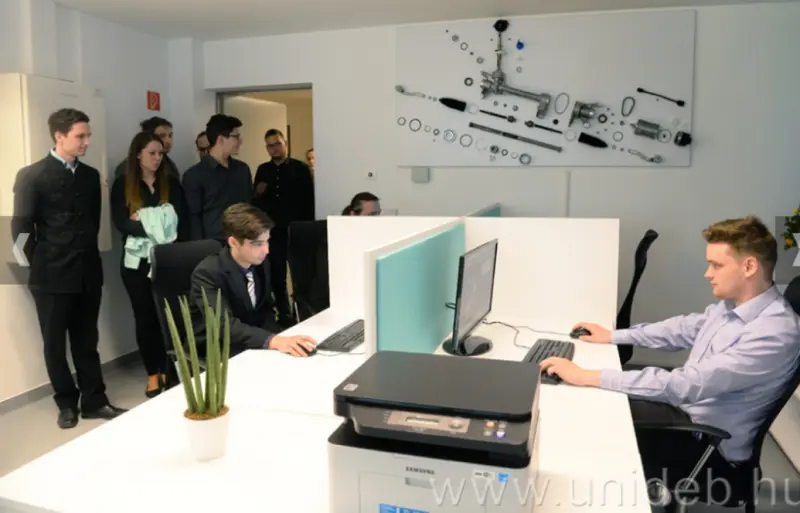
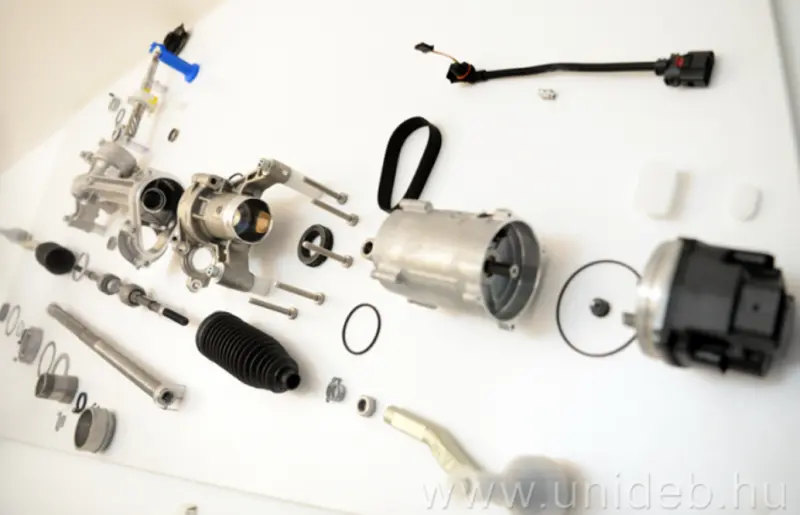
Aventics Hungary Pneumatics Laboratory
Purpose of the laboratory
Presentation and application of industrial tools in education. Preparing talented students for study competitions. Research and development.
Competence of the laboratory
- Presentation and training of pneumatic systems
- Research and development.
Our partners
Aventics Hungary Ltd.
Equipment in the laboratory
- Pneumatic cylinders, valves, valve islands, electropneumatic sensors
- L25 type PLC
- Indra Works PLC program
- Scheme Editor design program.
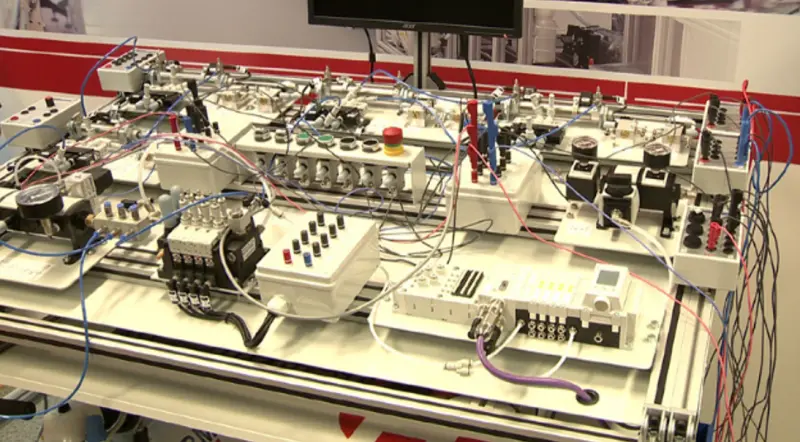
Medical Robotics Laboratory
Purpose of the laboratory
The laboratory is a research and development laboratory focusing on projects that challenges the medical technology field today. The laboratory has strong research and development partnership with the University of Debrecen and other national and international industrial and scientific institutions. The engineers at the laboratory have been involved in the development of the RGS stereotactic radiosurgery system at the University of Debrecen, Hungary.
Competence of the laboratory
With the increasing dose conformity achieved in modern radiation therapy techniques the requirements on the accuracy of patient positioning are becoming more and more critical in these machines. Robotic patient positioning tables consists of a dedicated robot with integrated patient table top and position feedback system can provide new level of accuracy for stereotactic radiosurgery.
Our Partners
Medikai Innováció Ltd.
Equipment in the laboratory
- UDMpm200702B2N1N,
- PDIcl22B2N,
- SP+EC-16000032NNNDNDNN,
- IOMnt-08-08-00-00-01,
- RESA30USA115B,
- AC Servo motor,
- Sesame Motor (gearbox) PEC70-100 Arcmin P2,
- Hantek PC- Oscilloscope,
- ACS Motion Control Software.
Vehicle Engine Performance Measurement and Diagnostic Laboratory
 Purpose of the laboratory
Purpose of the laboratory
The Vehicle Engine Performance Measurement and Diagnostic Laboratory provides an opportunity the students of Department of Mechanical Engineering (Automotive Engineering specialization) to learn about vehicle diagnostic measurements in practice. Students can carry out series of measurements in this laboratory about internal combustion engine performance, exhaust gas analysis and onboard diagnostic (OBD) systems. These measurements may connect to degree theses or scientific conference (TDK) work of students.
Competence of the laboratory
The installed measuring equipment of Vehicle Engine Performance Measurement and Diagnostic Laboratory have official calibration and authentication, therefore performance measurements, exhaust gas analyses, emission measurement and diagnostic tests carried out in this laboratory are all certified.
Our partners
Energotest Ltd.
Equipment in the laboratory
Rolling road dynamometer (TMP-350) with CAN bus based measurement data logger unit. The equipment is suitable for performance measurement of two-wheel-drive passenger cars and light duty vans up to 350 kW.
Exhaust gas analyser instrument (AVL DiGas 480) which is capable of measuring the composition of exhaust gas. The measuring system is also equipped with Diagnostic Trouble Codes scanner, diagnostic software and Autodata emission database.
The laboratory is equipped with more wind generators and exhaust gas extractors.
Mechanical Laboratory
Purpose of the laboratory
The laboratory is based on common testing methods of raw materials, technological materials and structures like welded joints. The devices in the lab follow the order of an ordinary materials testing method. There are several devices for test sample preparation (cutting, grinding). Comprehensive analysis of materials is made possible by the tensile-testing machine and the Charpy impact-testers.
Competence of the laboratory
Transferring the basic knowledge of the following lectures: Materials Testing, Technology of Structural Materials, Fracture Mechanics courses representing the testing processes by specialized test machines. Our lab is a scientific and technical background for PhD students providing the facilities to carry out experimental tests for research and scientific activities.
Equipment in the laboratory
- Tensile-testing machine (with computer-managed closed loop data storage & handling)
- Charpy impact-tester machines (computer-controlled from 0 to 450J impact range)
- Hardness tester (computer-managed)
- Furnace up to 1300°C (computer-managed heating & cooling curve)
- Heat treatment furnaces: RE-60, KO-14, ET-2
- Quenching vessels: water, oil, salt
- Hardness testers
- Temperature measurement & management equipment
NDT (Non-Destructive Testing) (Metallographic) Laboratory
Purpose of the laboratory
The laboratory is based on NDT testing of raw materials, technological materials and structures like welded joints. The devices in the lab follow the order of an ordinary materials testing method. There are several devices for test sample preparation (cutting, grinding, polishing and chemical conservation). Metallographic analysis of the prepared sample is made possible by a microscope. Besides, there are several pieces of NDT (metallographic) inspection equipment to create a comprehensive analysis of the material.
Competence of the laboratory
Teaching basic lectures like Materials Science, Technology of Structural Materials or Manufacturing Processes I-II-III. Supporting student measurements for scientific contests. With the up-to-date equipment and measuring techniques we are able to do different testing and structural analysis of special technological materials as research and scientific activities. Our lab is a scientific and technical background for PhD students.
Equipment in the laboratory
- Cutting, grinding and polishing machines to create samples
- Hardness testers (computer-managed HB, HRC, HV)
- Ultrasonic wall thickness measurement equipment
- Ultrasonic hardness tester
- Microscopes (Neophot with CCD & Olympus with CCD up to M=250x digital imaging)
- Image analysis software
- Furnace up to 1300°C (computer-managed heating & cooling curve)
- Qualified measuring tools (callipers, gauges, micrometers)
Welding Laboratory
Purpose of the laboratory
Instruction, presentation and practice of advanced welding procedures used in industry all over the world. Ensuring the proper technological environment for the construction of racing cars driven by compressed air or electric motors for students’ competitions.
Competence of the laboratory
Introducing basic welding processes by welding joints of test specimens. The laboratory supports the Materials Sciences and Manufacturing Engineering courses. The laboratory is equipped with eight welding dry boxes for electric arc-welding and one for gas-welding and metal cutting. Students learn and practise four different welding procedures
- Manual metal-arc-welding (MMA)
- MIG-MAG gas-shielded arc-welding (MIG-MAG)
- Wolfram electrode welding with argon shielding gas (GTAW-TIG, WIG)
- Gas welding, flame cutting and plasma cutting
Equipment in the laboratory
- MILLER Powcon-300 type welding machines for MMA welding
- MILLER Synchrowave-250 type welding machines for TIG welding
- MILLER MIGBLU-300 type welding machines for gas-shielded metal-arc-welding
- WELDI TIG-200i DC type welding machines for TIG and MMA welding
- WELDI AMIGO-250, WELDI MIG-320 Plus, WELDI MIG-420 type welding machines for gas-shielded metal-arc-welding
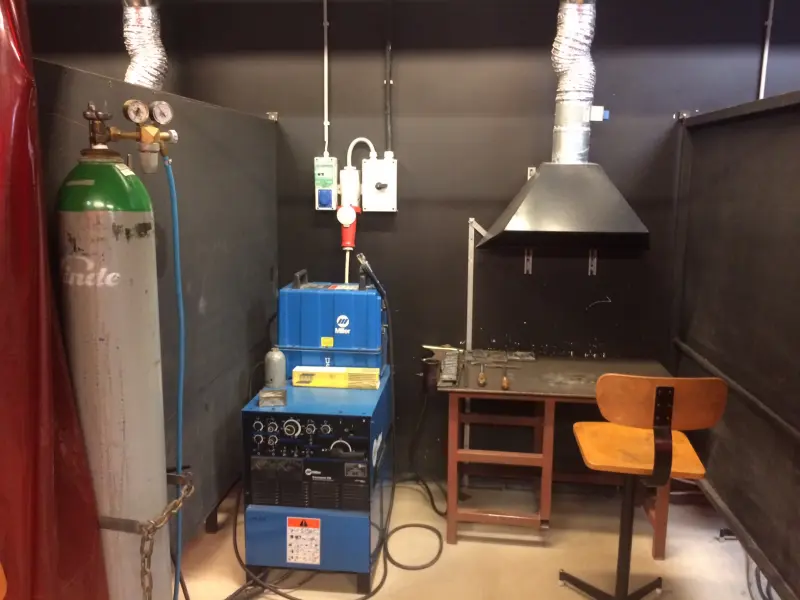
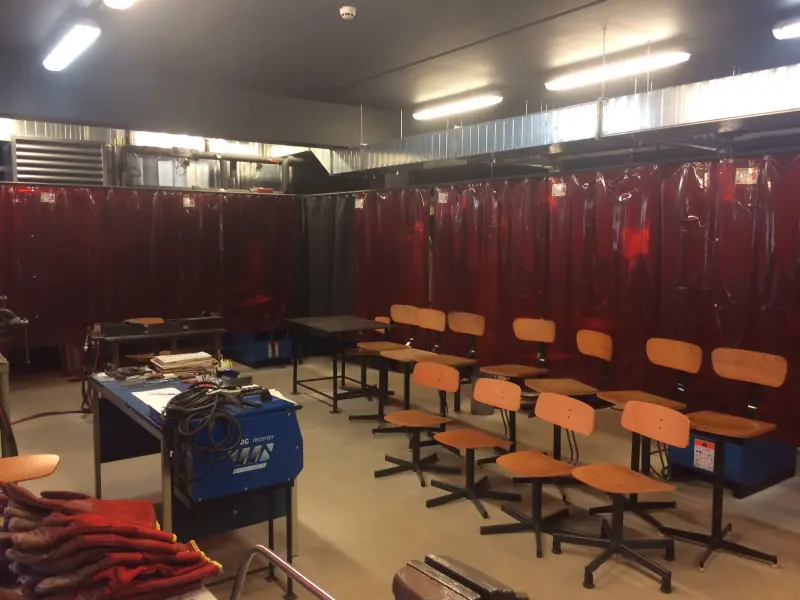
Engineering Diagnostics Laboratory
Purpose of the laboratory
Aims consist of achieving the diagnosis tests and measurements emerged in the general mechanical engineer applications. Moreover, repairing of machines is general part of the whole that is in close relation to the purposes of BSc mechanical engineer education.
After revealing defects of the certain machine by diagnostic methods further interventions are required which are mainly executed in the course of „machine-repairing„ courses.
Faulty machine parts are belonging to the laboratory for the students to examine their behaviour under certain conditions are close to real industrial applications. Hence all of them could get the knowledge far enough to make non-destructive material test as a broadly used method of machine fault diagnosis.
Student make a report they are asked for writing a detailed description about the steps of the measurements, their aims, to draw the conclusion and to make general analysis of the problem. Due to the high standard requirements, they are participated in deep knowledges are needed and help them to become essential member of the work team of their future work places.
Competence of the laboratory
One of the most used methods to analyse the status of a machine without destruction is the vibration analysis. Vibration parameters as displacement, velocity, acceleration should be measured in order to get information about the condition of the machines. Levels are mostly regulated by ISO 10816 standard. The higher values are measured the worse machine condition appeals. The laboratory is equipped with several vibration gadgets from the simplier to the more sophisticated ones. With the vibration analysis some typical machine faults can be detected like shaft deformation, unevenness, cracks, bearing faults etc. Sensors must be fixed steadily on the machine parts with magnet, glue and bore with thread inside. Not only the intensity of the vibration can be measured but the vibration spectrum as well. Fourier transform is a general method to change time to frequency so that signals could be showed for further analysis. Hand-held units as VibChecker SPM and more accurate ones as SPM Leonova Infinity can make this task easier. Furthemore it is sometimes needed to revise the status of roller element bearings. General vibration method does not applicable to make a reliable decision whether the unit is good or should be changed. SPM methods was developed to analyse bearings. On the inner or outside rings of the bearing several faults like cracks, holes can developed especially under high loads with extreme RPMs. These faults generate shock pulses with energy of low values. They are detected only with very sensitive special sensors that can filter out the peaks from the vibration spectrum efficiently. BearingChecker hand-held device and SPM Leonova Infinity are designed to check bearings.
Besides vibration measurements we broadened the diagnosis methods with acoustic tests. In the laboratory there are SPL units capable of measuring noise from 20 Hz to 20000 Hz. Additionally, noise spectrum can be calculated by Fourier transform as it was shown previously in the vibration measurement. It serves information which frequencies are the higher ones in the whole spectrums. It is important if one would like to apply hear protective kits because their SNR value is related to frequency.
If frequency is above 20000 Hz ultrasonic sensors should be used for detecting leakages, cracks both in machine parts and in pipe line systems. It is a perfect way for checking valves as well.
Endoscope can detect inner parts of a complex unit by leading a fibre glass pipe into the machine. Through optical elements tiny parts can be scaled up then recorded if necessary.
Lubrication tests can be applied in this laboratory greases, oils are commonly analysed by tribology ways.
Finally, I would like to emphasize the importance of thermography measurements. TIC type Flir help the tests in order to classify machine elements, their faults on the basis of thermal radiation.
Our partners
- SKF Group
- FAG Schaeffler Technologies AG & Co. KG · Deutschland
- GRIMAS HungaryLtd.
- SPM Instrument Budapest Ltd.
- KE-TECH Ltd.
This laboratory is founded with the help of these partners.
Equipment in the laboratory
- Oilcheck oil tester
- CMVP 10 vibration tester
- CMVP 30 SEE tester
- SPM analysator with PRO32-2 and PRO46-2 softwares
- VIB 10 vibrometer
- Testo 816 noise meter
- Center 320 noise meter
- Infrared thermal meter
- UNIBALANCE 4 balancing rig
- SPM Leonova Infinity universal vibration tester
- SPM Vibchecker
- SPM Bearingchecker
- Flir (ThermaCAM E45)
- National Instrument card for measurements
- Labview software
- Audacity acoustic software
Machine Elements Laboratory
Purpose of the laboratory
The Machine Elements Lab Practice is part of the Machine Elements course, which introduces machine elements and machine constructions built up of them to students and familiarizes them with the material taught at lectures. Machines and equipment in the lab are designed in the framework of the four designing tasks: Welded Machinery Base; Hydraulic Cylinder; External Double-Shoe Thruster Released Drum Brake and Counterdrive, which may be dismantled and assembled with the guidance of the instructor.
Competence of the laboratory
Students have the opportunity to gain hands-on experience with machine elements and parts and study their construction and operation methods. The lab provides the background for the technical knowledge and hands-on skills required by the educational and outcome requirements of the training program. Students have the opportunity to design the four designing tasks, operate and maintain mechanical systems. The lab is equipped with test-benches instrumented with an up-to-date measuring system comprising an amplifier and evaluating software which are suitable for the fast, electrical measurement of mechanical parameters changing with time.
Our partners
Hottinger Baldwin Messtechnik Ltd (HBM)
Equipment in the laboratory
Test-benches for testing drive train vibration, bolted joints, spring operation, endurance limit of composite materials and friction phenomenon between surfaces and so on.
The lab is instrumented with Spider 8 amplifier and CATMAN Easy software from HBM for acquisition and evaluation of the measurement signals provided by transducers for the measurement of force, pressure, acceleration, torque and displacement. The Catman software package running under MS-Windows is applied for experimental stress analysis with strain gauges and an on-line measurement system.
The applied transducers and gauges
- force transducers: measure static and dynamic tensile and compressive loads
- torque transducers: in rotating and non-rotating version
- pressure transducers: for absolute and differential pressure measurements
- displacement transducers
- strain gauges for determining the strain on the surface of components
- piezoelectric accelerometer.
CAD laboratory
Purpose of the laboratory
In industry, there are several integrated CAD/CAM solutions. The aim of the laboratory is to introduce the integrated design systems with students and lead on product lifecycle from inception, through engineering design and manufacture.
Competence of the laboratory
- Parametric modeling method
- Finite element analysis
- Computer aided manufacturing
Our partners
S&T Consulting Hungary Ltd., Enterprise Hungary, Econ Engineering Ltd.
Equipment in the laboratory
- workstation computers
- PTC Creo 3.0
- ANSYS Workbench R18.2
- FEMAP 9.3
- Solid Edge ST10
- Solidworks 2016
- AutoCAD 2017
- EdgeCAM 2014 R2
- LabVIEW
- Matlab